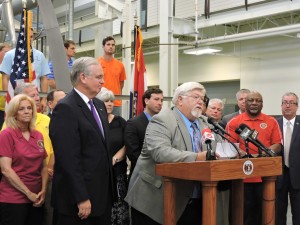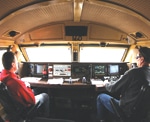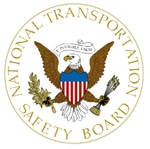
Due to the Republican Party’s lock on midterm elections, this year marks the first time that anti-worker groups were able to foster enough support in the state Legislature to send a bill to the Governor. The Legislature effectively shut down the last week of it’s session after some GOP senators forced a vote on the measure.
Even with an overwhelming and record number of Republicans in the Missouri House and Senate, the bill’s original passage still fell short of the two-thirds majority vote needed in both chambers to overturn Governor Nixon’s veto. The Republican Party was split, with many members joining Democrats in opposition to the extreme legislation.
To override the veto, the Republican-controlled Legislature would need 23 votes in the Senate and 109 in the House. The Senate passed the measure 21-13 earlier this year while the House passed it 92-66.
Author: amyr

According to the resolution — LR 338 — safety risks posed by shipments of such materials as ethanol, Bakkan crude oil and chlorine could be reduced by requiring a train crew of at least two individuals.
The resolution was sponsored by Sen. Al Davis of Hyannis. The legislature adopted it by a 36-4 vote on May 28.
Read more from the North Platte Bulletin.

The FAA plans to build on that success by working with airport sponsors over the next 10-15 years to further reduce runway risks through risk-based decision-making. A new FAA national initiative known as the Runway Incursion Mitigation (RIM) program will identify airport risk factors that might contribute to a runway incursion and develop strategies to help airport sponsors mitigate those risks.
Runway incursions occur when an aircraft, vehicle, or person enters the protected area of an airport designated for aircraft landings and take offs. Risk factors that contribute to runway incursions may include unclear taxiway markings, airport signage, and more complex issues such as the runway or taxiway layout. Through RIM, the FAA will focus on reducing runway incursions by addressing risks at specific locations at the airport that have a history of runway incursions.
Risk-based decision-making builds on safety management principles by using a consistent approach to proactively address emerging safety risks. The FAA already has collected and reviewed data to identify specific airport areas with risk factors that could contribute to a runway incursion. The FAA has developed a preliminary inventory of airport locations where runway incursions have occurred. The FAA will work with the airport sponsors to develop strategies to mitigate runway incursions at these locations.
The FAA has kicked off the new initiative as it is wrapping up an extremely successful 15-year program to improve and standardize runway safety areas at the nation’s top commercial service airports.

Foxx
WASHINGTON – U.S. Transportation Secretary Anthony Foxx announced today that the Department’s National Highway Traffic Safety Administration (NHTSA) has finalized its rule requiring electronic stability control (ESC) systems on heavy trucks and large buses (FMVSS No. 136).
“ESC is a remarkable safety success story, a technology innovation that is already saving lives in passenger cars and light trucks,” Foxx said. “Requiring ESC on heavy trucks and large buses will bring that safety innovation to the largest vehicles on our highways, increasing safety for drivers and passengers of these vehicles and for all road users.”
ESC works instantly and automatically to maintain directional control in situations where the driver’s own steering and braking cannot be accomplished quickly enough to prevent the crash. The National Transportation Safety Board has recommended a requirement for ESC on heavy-duty vehicles since 2011. The Moving Ahead for Progress in the 21st Century Act (MAP-21), enacted in 2012, directed NHTSA to consider an ESC requirement for motorcoaches, which are covered in today’s rule. A rule requiring light-duty vehicles to include ESC took effect in 2012.
“Reducing crashes through ESC in these trucks and buses will save lives – nearly 50 each year. It will move goods and people more efficiently and reduce the toll crashes take on our economy through traffic delays and property damage,” said NHTSA Administrator Mark Rosekind. “It’s a win for the safety and convenience of the traveling public and for our economy.”
NHTSA estimates the rule will prevent as many as 1,759 crashes, 649 injuries and 49 fatalities each year. ESC will prevent up to 56 percent of untripped, rollover crashes – that is, rollover crashes not caused by striking an obstacle or leaving the road.
The final rule announced today requires ESC systems on heavy trucks and large buses exceeding 26,000 pounds in gross weight. Compliance will be tested using a “J-turn” test that replicates a curved highway off-ramp. It will take effect for most heavy trucks two years from publication. The requirement will take effect in three years for buses larger than 33,000 pounds and four years for those weighing between 26,000 and 33,000 pounds.

The railroad employs about 47,000 people across its system, 8,000 in Nebraska.
Union Pacific Corp. also has mothballed locomotives as its transport volumes run 4 percent lower so far this quarter, compared with a 2 percent drop in the first quarter.
Read more from the Journal Star.

While cargo operators would save money with a single person in the cab instead of two people, that argument will be a tough sell to railroad workers and union leaders after the May 12 accident in Philadelphia, Fritz said. Amtrak trains in the Northeast Corridor have used solo engineers since 1983, according to a union statement.
“It makes the conversation more difficult today,” Fritz said in an interview at Bloomberg’s headquarters in New York Wednesday. “That’s because it becomes a more emotional conversation as opposed to a conversation grounded in fact and the capability of technology.”
Read more from Bloomberg Business.

The bridge in Koochiching County belongs to Canadian National Railway. It carried more than 20 trains over the Rat Root River daily until it collapsed.
CN spokesman Brent Kossey said the crew of a southbound train approaching the bridge reported a fire on the trestle just after 12:30 a.m. The train came to a stop but only after it had crossed the bridge. The bridge was destroyed, but the crew was not hurt.
Read more from the Winona Daily News.
The FAA is working with the commercial aviation and medical communities to study the emotional and mental health of U.S. commercial pilots.
The joint FAA and industry group known as the Commercial Aviation Safety Team (CAST) recommended the study based on the recent Malaysia Flight 370 and Germanwings Flight 9525 accidents.
The Pilot Fitness Aviation Rulemaking Committee (ARC) will provide the FAA with recommendations within six months. The group will include U.S. and international government and industry aviation experts, including a working group of medical professionals who specialize in aerospace medicine.
U.S. pilots undergo robust medical screening, but recent accidents in other parts of the world prompted the FAA to take a new look at the important issue of pilot fitness.
The ARC will examine issues including the awareness and reporting of emotional and mental health issues, the methods used to evaluate pilot emotional and mental health, and barriers to reporting such issues.
Based on the group’s recommendations, the FAA may consider changes to medical methods, aircraft design, policies and procedures, pilot training and testing, training for Aerospace Medical Examiners, or potential actions that may be taken by professional, airline, or union groups. The ARC’s meetings will not be open to the public.
Federal Aviation Regulations outline the medical requirements for pilots. U.S airline pilots undergo a medical exam with an FAA-approved physician every six or twelve months depending on the pilot’s age.

The last SkyWest/United Express flights between Pueblo Memorial Airport and Denver International Airport will take place June 3, city aviation director Mark Lovin said Tuesday.
The service interruption could last a month or more, Lovin said. Passengers who booked flights after June 3 have been offered optional flights out of the Colorado Springs Airport or refunds, he said.
Read more from The Pueblo Chieftain.

WASHINGTON – The National Transportation Safety Board issued a Safety Alert urging pilots to vigilantly look out for other aircraft and to make their own presence known.
The Board has investigated numerous general aviation accidents in which pilots operating near one another did not maintain adequate visual lookout and failed to see and avoid other aircraft. Investigators also note that pilots can be distracted by technology such as cell phones, tablets and other devices that challenge the see-and-avoid concept.
“As a pilot, your first job is to fly your own airplane,” said NTSB Chairman Christopher A. Hart, who is also a pilot. “Part of that job is to scan for other airplanes. On-board traffic advisory systems are not a substitute for an outside visual scan.”
The safety alert advises pilots to scan for traffic throughout their flight, clearly communicate intentions, use lights to be more conspicuous and encourage passengers to help scan for other aircraft.
This and other Safety Alerts are available at: http://www.ntsb.gov/safety/safety-alerts/Documents/SA_045.pdf.